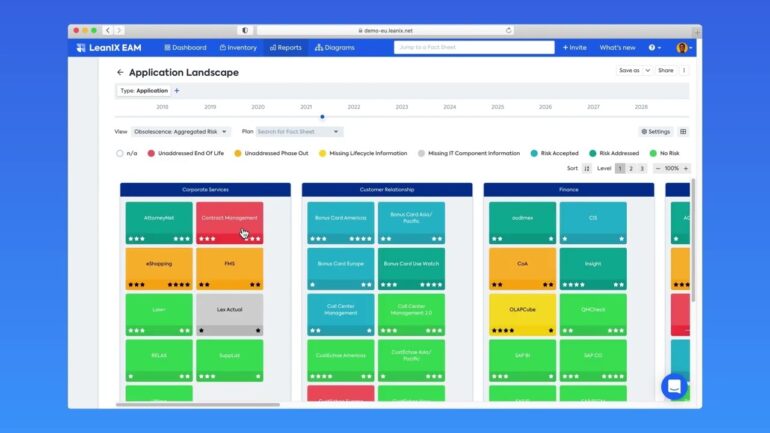TL;DR:
- SAP’s acquisition of LeanIX aims to expedite the transition of customers from on-premises legacy software to S/4HANA in the cloud.
- LeanIX’s expertise in generative AI is set to enhance SAP’s capabilities in enterprise architecture management.
- LeanIX, with 1,000 clients, is particularly strong in the US market, contributing 50% of its revenue.
- The integration of AI in managing enterprise architecture is a focal point for LeanIX and its clients.
- Data-driven insights from LeanIX are gaining significance in modern IT departments.
- SAP’s commitment to S/4HANA migration faces challenges, with only 12% of customers completing the transition.
- SAP’s prior acquisitions, like Signavio, and initiatives like “Rise with SAP,” underscore its dedication to supporting customers in this transition.
- Demand for process mining software, exemplified by Signavio, remains robust in 2023.
- SAP’s assurance to continue supporting non-SAP customers underscores its commitment to holistic enterprise architecture views.
Main AI News:
In a bold strategic maneuver, SAP, a global leader in enterprise software, has recently announced its acquisition of LeanIX, a German enterprise architecture management specialist. This acquisition comes at a crucial juncture as SAP seeks to accelerate its customers’ transition from legacy on-premises software to the cutting-edge S/4HANA in the cloud. The integration of LeanIX’s expertise, particularly in harnessing the potential of artificial intelligence (AI), promises to be a game-changer in this endeavor.
LeanIX boasts a significant client base, with around 1,000 customers using its Enterprise Architecture Management (EAM) Software as a Service (SaaS) offering. Notably, the United States stands as one of its largest markets, contributing a substantial 50% of its revenue, with 30% of its customers based there. André Christ, CEO of LeanIX, highlighted the pivotal role of generative AI in the company’s growth. LeanIX has pioneered the integration of AI assistants to manage enterprise architecture, not only for itself but also for its customers, aiding them in the seamless adoption of AI in their IT infrastructure and processes.
The data-driven insights provided by LeanIX are increasingly integral to the operations of IT departments, as they navigate the complexities of modern business processes and the underlying infrastructure. According to Christ, enterprise architects are no longer secluded in an “ivory tower.” Instead, they are becoming indispensable contributors, actively driving business transformations.
This aligns seamlessly with SAP’s strategic vision, as it urges its customers to migrate their ERP systems to S/4HANA in the cloud. While SAP initially committed to supporting S/4HANA through 2040, it plans to cease support for legacy ECC6 and Business Suite 7 applications by the end of 2027. However, a recent survey conducted by LeanIX reveals that only 12% of SAP customers have completed this transition, highlighting the substantial work ahead for SAP, its customers, and system integrators.
SAP has been proactive in addressing this challenge. In early 2021, it acquired process mining company Signavio to assist enterprises in identifying and improving their existing processes, thereby facilitating their transition to S/4HANA. Moreover, the launch of “Rise with SAP” in February 2021 introduced an all-in-one solution encompassing licensing, maintenance, and cloud hosting of SAP’s core ERP applications, positioning itself as a transformative digital service.
Notably, demand for process mining software remains robust in 2023, with Signavio emerging as a key growth area within SAP. LeanIX, having partnered with Signavio for an extended period, shares over 500 joint customers with SAP, including some prestigious household names.
While the acquisition of LeanIX will undoubtedly grant SAP greater control over the software’s capabilities, it’s crucial to note that SAP is committed to supporting non-SAP customers even after the deal’s closure later this year. Rouven Morato, GM at SAP Signavio, emphasized the importance of providing a holistic view of enterprise architecture to customers, irrespective of their SAP usage. Sebastian Steinhaeuser, SAP’s Chief Strategy Officer, affirmed this commitment, highlighting SAP’s shift toward an open ecosystem strategy.
In this dynamic landscape, SAP’s acquisition of LeanIX represents not just a strategic move but also a commitment to innovation and customer-centricity. As the two industry giants join forces, they are poised to redefine the landscape of enterprise software and shape the future of process optimization.
Conclusion:
SAP’s acquisition of LeanIX signifies a significant step towards process optimization and modernization within the enterprise software market. By integrating LeanIX’s AI capabilities and data-driven insights, SAP is poised to better support its customers in their migration to S/4HANA in the cloud. Furthermore, SAP’s commitment to supporting non-SAP customers reflects its dedication to offering holistic solutions in an evolving business environment. This move positions SAP as a formidable player in shaping the future of enterprise software.

